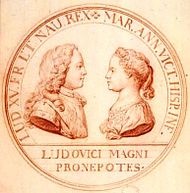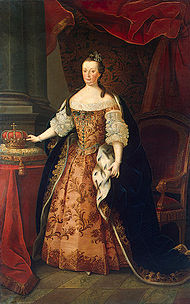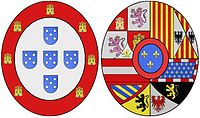- Mariana Victoria of Spain
-
Mariana Victoria of Spain 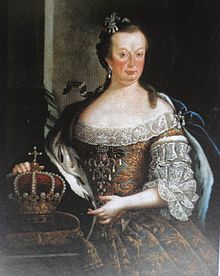
Mariana Victoria as Queen of Portugal Queen consort of Portugal Tenure 31 July 1750 – 24 February 1777 Spouse Joseph I of Portugal Issue Maria I, Queen of Portugal
Infanta Mariana Francisca
Infanta Doroteia
Benedita, Princess of BrazilHouse House of Braganza
House of BourbonFather Philip V of Spain Mother Elisabeth Farnese Born 31 March 1718
Royal Alcazar of Madrid, SpainDied 15 January 1781 (aged 62)
Barraca Real of Ajuda, PortugalBurial 17 January 1781
Monastery of São Vicente, PortugalMariana Victoria of Spain (31 March 1718 – 15 January 1781) was an Infanta of Spain by birth and was later the Queen of Portugal as wife of King Joseph I. The eldest daughter of Philip V of Spain and Elisabeth Farnese, she was engaged to the young Louis XV of France at the age of seven.[1] Rejected due to her age, the marriage never took place and she was sent back to Spain. In 1729 she was married to the son of John V of Portugal.[2] The mother of Maria I of Portugal she also acted as regent of Portugal during the last months of her husbands life and acted as advisor to her daughter in her reign.
Contents
Background
Mariana Victoria was born at the Royal Alcazar of Madrid in Madrid and was given the same forenames as her paternal grandmother Maria Anna Victoria of Bavaria, wife of Le Grand Dauphin. She was an Infanta of Spain by birth and the eldest daughter of Philip V of Spain and his second wife Elisabeth Farnese.[3] Her father was a grandson of Louis XIV and had inherited the Spanish throne in 1700. At the time of her birth, Mariana Victoria was fifth in line to the throne of Spain behind her half brothers Infante Louis, Prince of Asturias, Infante Ferdinand, Infante Pedro as well as her full brother Infante Charles. As in Infanta of Spain she had the style of Royal Highness.
Engagement to Louis XV
After the War of the Quadruple Alliance, France and Spain decided to reconcile by engaging the Infanta Mariana Victoria to her first cousin the young Louis XV of France. Organised by Philippe d'Orléans, Regent of France for the ten year old Louis XV,[1] the match was part of a wider set of engagements which included the proposal of Philip V's eldest son Infante Louis, Prince of Asturias to Élisabeth d'Orléans, Mademoiselle de Montpensier followed by another proposal between Philippine Élisabeth d'Orléans, Mademoiselle de Beaujolais to the young Infante Charles.[4]
Saint-Simon, the French ambassador, requested her hand on 25 November 1721. The exchange of the young Infanta and Mademoiselle de Montpensier was on the Île des Faisans ("Isle of Pheasents") and was the site was where their common ancestors, Louis XIV and Maria Theresa of Austria had met in 1660. Mariana Victoria arrived in Paris on 2 March 1721 amongst much celebration and took up residence at the Palais du Louvre. The young Infanta was nicknamed the l'infante Reine ("Queen-Infanta")[4] as the couple were not to be married till Mariana Victoria reached a more mature age. Mariana Victoria was in awe of Louis XV and was popular with the court apart from the king himself who avoided her presence.[5]
According to the mother of the Régent, Elizabeth Charlotte of the Palatinate, Mariana Victoria was the "sweetest and prettiest little thing" and had considerable wit for her age. Her education was placed in the care of Marie Anne de Bourbon, an illegitimate daughter of Louis XIV and Louise de La Vallière. In February 1723, Louis XV reached his majority and thus governed the country by his own accord.[6]
Her establishment in France was not to be. Under the influence of the Prime Minister Louis Henri, Duke of Bourbon and his mistress Madame de Prie, the decision was made to send the seven year old Mariana Victoria was sent back to Spain on 11 March 1725. Bourbon had wanted to maintain influence over the young Louis XV and offered his sister Henriette Louise de Bourbon as a potential wife who, unlike Mariana Victoria, was old enough to conceive. The situation was not helped by the Spanish rejection of Louise Élisabeth d'Orléans whose husband died having ruled as Louis I of Spain for only seven months.[4] As their marriage had not been consummated, the Spanish refused to support her and ordered she return to France with her sister Philippine Élisabeth. Mariana Victoria left Versailles on 5 April 1725 and travelled to the frontier where she and the two Orléans daughters were then exchanged. Louis XV subsequently married Marie Leszczyńska in September 1725 and Mariana Victoria's sister the Infanta Maria Teresa Rafaela married Louis XV's son in 1745 to reassure the insulted Spanish court.
Engagement to Joseph I
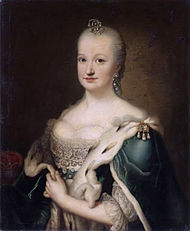 Mariana Victoria while Princess of Brazil by an unknown artist and misidentified as her sister Maria Teresa Rafaela.
Mariana Victoria while Princess of Brazil by an unknown artist and misidentified as her sister Maria Teresa Rafaela.
Her arrival in Spain was not taken as a great insult and caused a diplomatic rift between Spain and France. The offended Spanish soon after concluded a treaty with Austria in the form of the 1725 Treaty of Vienna, whilst England sought support from France. Having remained unmarried, she was still eligible to inherit the throne but was displaced by her younger brother Infante Philip who was born in 1720. Discussions with the Kingdom of Portugal began in 1727 and a marriage was negotiated by the Portuguese ambassador the Marquis of Abrantes. She was a rumoured bride for Emperor Peter II of Russia, grandson of Peter the Great.[7] Another double marriage was planned. Mariana Victoria would marry the Infante José, "Prince of Brazil", son and heir of João V of Portugal. Her older half brother Ferdinand, "Prince of Asturias" would marry José's sister the Infanta Bárbara.[2] Mariana Victoria married the Prince of Brazil (traditional title for the Portuguese heir to the throne) on 19 January 1729 at Elvas in Portugal.[3] The Prince of Asturias (traditional title for the Spanish heir to the throne) married the Infanta Bárbara the next day at Badajoz. From her marriage till the time of her husbands accession to the throne in 1750, she was styled Her Royal Highness the Princess of Brazil.
Husband and wife would soon have a close relationship. The couple enjoyed hunting as well as music – Mariana Victoria was an accomplished singer – patronised Italian opera singers and the theatre but were both passionately religious. Despite this, her husband maintained various mistresses much to the dislike of his strong willed wife. During her marriage, Mariana Victoria gave birth to eight children four of which survived infancy.[3] Her first child Infanta Maria was given the style Princess of Beira as the heir apparent to her father. Two of Mariana Victoria's daughters remained unmarried. Her daughter Infanta Mariana Francisca was a proposed bride for the Dauphin of France, son of Louis XV but Mariana Victoria herself rejected the plan. When her other daughter Infanta Doroteia was proposed as a wife for the future Philippe Égalité Mariana Victoria again refused to the match. Her youngest daughter Infanta Benedita married José, Prince of Brazil, Mariana Victoria's grandson. The latter marriage was organised by Mariana Victoria herself after the death of her husband.[8]
Queen, regent and widow
At the death of her father-in-law, King John V in 1750, her husband became the ruler of the Portuguese Empire which had significant territories in South America. Her husbands reign was dominated by the influence of the Marquis of Pombal who had was a favourite of the Queen mother. Joseph I soon left the governing of the state to Pombal who used his power to remove the influence of the church at the court as well as that of his enemies. Mariana Victoria and her daughter disliked the influence Pombal had over Joseph I. Her husbands reign was marred by the devastating 1755 Lisbon earthquake of 1 November 1755 which killed 100,000. The earthquake caused Joseph I to develop a severe case of claustrophobia and he was never again comfortable living within a walled building. Consequently, he moved the royal court to an extensive complex of tents in the hills of Ajuda. It was Pombal who organised the reconstruction of Lisbon in the aftermath of the earthquake.
In 1759, the Távora affair emerged after an assassination attempt on her husband failed and the powerful Távora family were, in the eyes of Pombal, completely responsible for the attack. Pombal later ordered the execution of all members of the noble family and it was only at the intervention of Mariana Victoria and her daughter, the Princess of Brazil that some women and children were spared. As Pombal was de facto ruler of the state, Mariana Victoria and her husband took a less prominent role in politics.
Her husband, having suffered from a series of strokes decided to allow his wife to take his place as head of government.[9] As such, Mariana Victoria was created Regent of Portugal in her husbands name. Created Regent on 29 November 1776, she remained so till her husbands death on 24 February 1777.[9] Upon her husband's death, their eldest daughter became the first queen regnant as Maria I. Throughout her daughter's reign she used to exert much influence on her daughter who would often ask her mothers advice on most matters of state. In the early days of Maria I's reign, Pombal was exiled to the country.[9]
When her daughter had assumed government, Mariana Victoria took it upon herself to improve relations with her native Spain which was ruled by her older brother Carlos III. The two countries had been in conflict regarding territorial possessions in the Americas. Leaving Portugal on 28 October 1777, Mariana Victoria travelled to Spain where she stayed for just over a year, residing both in Madrid and at Aranjuez.[10] Mariana Victoria helped bring about a treaty between the two nations which was to be cemented by a double marriage between her grandchildren. These unions were between Charles III's son Infante Gabriel and Mariana Victoria's grand daughter the Infanta Mariana Vitória. The second marriage was between the Infanta Carlota, eldest granddaughter of Carlos III Infante João. While in Spain Mariana Victoria had had an attack of Rheumatism and used a wheelchair for some time in August 1778. She returned to Portugal in November 1778. Her illness was furthered when it became clear that she was suffering from Heart disease as well.[11] The elderly Mariana Victoria died at the Real Barraca de Ajuda, a building which is where the present Ajuda National Palace is. She was buried at the Monastery of São Vicente in Lisbon.
Legacy
She was the godmother of Marie Antoinette who was born on the same day as the 1755 Lisbon earthquake devastated Lisbon. Mariana Victoria has descendants ranging from the present King of Spain, King of Belgium, Grand Duke of Luxembourg pretending Duke of Parma and the French Count of Paris. In 1822, her great-grandson Pedro I of Brazil became the first emperor of Brazil.
Issue
- Maria I of Portugal (17 December 1734 – 20 March 1816) married Infante Pedro of Portugal and had issue. Later queen of Portugal.
- Mariana Francisca of Portugal (7 October 1736 – 6 May 1813) died unmarried.
- Doroteia of Portugal (21 September 1739 – 14 January 1771) died unmarried.
- Benedita of Portugal (25 July 1746 – 18 August 1829) married Infante Joseph, Prince of Beira, no issue.
Ancestors
Titles, styles, honours and arms
Titles and styles
- 31 March 1718 – 19 January 1729 Her Royal Highness Infanta Mariana Victoria of Spain
- 19 January 1729 – 31 July 1750 Her Royal Highness the Princess of Brazil, Duchess of Braganza
- 31 July 1750 – 29 November 1776 Her Most Faithful Majesty the Queen of Portugal and the Algarves
- 29 November 1776 – 24 February 1777 Her Most Faithful Majesty the Queen Regent of Portugal and the Algarves
- 24 February 1777 – 15 January 1781 Her Most Faithful Majesty the Queen Mother of Portugal and the Algarves
Arms
Arms of the House of Bourbon and House of Braganza
References
- ^ a b Armstrong, p 243
- ^ a b Armstrong, p 265
- ^ a b c van de Pas, Leo. "Infanta Mariana Victoria of Spain". Genealogics .org. http://www.genealogics.org/getperson.php?personID=I00000815&tree=LEO. Retrieved 2010-09-21.
- ^ a b c François Velde (4 July 2005). "The Abdication of the throne of Spain by Felipe V (1724)". heraldica.org. http://www.heraldica.org/topics/france/felipe-a.htm. Retrieved 2010-09-25.
- ^ Pevitt, p 288
- ^ Pevitt, p 284
- ^ Armstrong, p 264
- ^ Roberts, p 53
- ^ a b c Roberts, p 51
- ^ Roberts, p 65
- ^ Roberts, p 62
Bibliography
- Armstrong. Edward: Elisabeth Farnese: The Termagant of Spain, 1892
- Myrl. Jackson-Laufer. Guida: Women rulers throughout the ages: an illustrated guide, ABC-CLIO, 1999, ISBN 9781576070918
- Pevitt. Christine : The Man Who Would Be King: The Life of Philippe d'Orléans, Regent of France, Phoenix, London, 1997, ISBN 9780753804599
- Roberts. Jennifer: The Madness of Queen Maria: The Remarkable Life of Maria I of Portugal; Templeton Press, London, 2009, ISBN 9780954558918
External links
 Media related to Mariana Victoria of Spain at Wikimedia Commons
Media related to Mariana Victoria of Spain at Wikimedia CommonsSee also
Mariana Victoria of SpainBorn: 31 March 1718 Died: 15 January 1781)Portuguese royalty Preceded by
Archduchess Maria Anna of AustriaQueen consort of Portugal and the Algarves
31 July 1750 – 24 February 1777Succeeded by
Vacant
Infanta Charlotte Joaquina of SpainThe generations indicate descent form Charles I, under whom the crowns of Castile and Aragon were united, forming the Kingdom of Spain. Previously, the title Infanta had been largely use in the different realms. 1st Generation Maria, Holy Roman Empress · Joan, Princess of Portugal2nd Generation Isabella Clara Eugenia, Co-sovereign of the Habsburg Netherlands · Catherine Michelle, Duchess of Savoy · Infanta Maria3rd Generation 4th Generation Infanta María Margarita · Infanta Margarita María · Infanta Maria Eugenia · Infanta Isabel María · Infanta Mariana · Maria Theresa, Queen of France · Margarita Teresa, Holy Roman Empress · Infanta Maria Ambrosia5th Generation none6th Generation none7th Generation Maria Anna Victoria, Queen of Portugal · Maria Teresa Rafaela, Dauphine of France · Maria Antonia Ferdinanda, Queen of Sardinia8th Generation Infanta Maria Isabel · Infanta Maria Josefa · Infanta María Isabel Ana · Infanta Maria Josepha · Maria Luisa, Holy Roman Empress · Infanta Maria Teresa · Infanta Maria Ana9th Generation Carlota Joaquina, Queen of Portugal · Infanta Maria Luisa · Infanta Maria Amalia · Maria Louisa, Queen of Etruria · Maria Isabella, Queen of the Two Sicilies · Infanta Maria Teresa10th Generation Isabella II · Luisa Fernanda, Duchess of Montpensier · Maria Luisa, Crown Princess of Saxony* · Isabella, Countess Ignaz Gurowski* · Luisa, Duchess of Sessa* · Infanta Josefina, Mrs. José Guëll* · Infanta Maria Cristina* · Amelia Philippina, Princess Adalbert of Bavaria*11th Generation Isabella, Princess of Asturias · Infanta Maria Cristina · Maria de la Concepcio · Maria de Pilar · Maria de la Paz, Princess Louis Ferdinand of Bavaria · Eulalia, Duchess of Galliera · Maria Isabella, Countess of Paris* · Infanta Amalia of Orléans* · Infanta Cristina d'Orléans* · Infanta Maria de la Regla of Orléans* · Mercedes, Queen of Spain*12th Generation Mercedes, Princess of Asturias · Maria Teresa, Princess Ferdinand of Bavaria13th Generation Beatriz, Princess of Citivella-Cesi · Maria Cristina, Countess of Marone · Isabel Alfonsa, Countess Jan Kanty Zamoyski* · Mercedes, Princess Bagration of Mukhrani* · Infanta Pilar of Bavaria*14th Generation 15th Generation 16th Generation *title granted by Royal Decree The generations indicate descent from Afonso I, and continues through the House of Aviz, the House of Habsburg through Isabella of Portugal, and the House of Braganza through Infanta Catherine, Duchess of Braganza. 1st Generation 2nd Generation Infanta Urraca of Castile • Aurembiaix, Countess of Urgell • Jeanne, Countess of Flanders3rd Generation Matilda II, Countess of Boulogne • Sancha Fernández de Lara4th Generation Infanta Violante Manuel of Castile5th Generation Infanta Beatrice of Castile6th Generation 7th Generation Maria Teles de Menezes • Constance de Trastámara, Lady of Alba de Tormes • Juana de Trastámara, Lady of Cifuentes8th Generation 9th Generation Charlotte, Queen of Cyprus • Infanta Beatriz of Portugal*10th Generation Infanta Leonor of Portugal* • Isabella, Princess of Asturias11th Generation 12th Generation 13th Generation Countess Emilia of Nassau^ • Luísa Osório^14th Generation 15th Generation 16th Generation none17th Generation Infanta Mariana Victoria of Spain18th Generation none19th Generation Infanta Benedita of Portugal* • Infanta Carlota of Spain20th Generation 21st Generation Princess Elisabeth of Thurn and Taxis • Princess Maria Theresa of Löwenstein-Wertheim-Rosenberg • Princess Maria Amalia of the Two Sicilies** • Infanta Maria Cristina of Spain**22nd Generation Anita Stewart Morris • Princess Francisca of Orléans and Braganza23rd Generation 24th Generation Princess Augusta Victoria of Hohenzollern*also an Infanta of Portugal by birth, **also an infanta of Spain, ^position as infanta not accepted Infanta Barbara of Portugal* (1711-1712) · Infanta Mariana Victoria of Spain (1729-1750) · Maria I of Portugal* (1750-1777) · Infanta Benedita of Portugal (1777-1788) · Infanta Carlota of Spain (1788-1816) · Archduchess Maria Leopoldina of Austria (1817)*held the title in her own right Portuguese royal consorts Maud of Savoy (1146-1157) · Dulce of Aragon (1185-1198) · Urraca of Castile (1211-1220) · Mécia Lopes de Haro (1246–1248) · Matilda of Boulogne (1248–1253) · Beatrice of Castile (1253-1279) · Elizabeth of Aragon (1282-1325) · Beatrice of Castile (1225-1257) · Inês de Castro (1360) · Leonor Telles de Menezes (1372-1383) · Philippa of Lancaster (1387-1415) · Eleanor of Aragon (1433-1438) · Isabella of Coimbra (1447-1455) · Joanna of Castile (1475–1479) · Eleanor of Viseu (1481-1495) · Isabella of Aragon (1497-1498) · Maria of Aragon (1500 -1517) · Archduchess Eleanor of Austria (1518-1521) · Archduchess Catherine of Austria (1525-1557) · Archduchess Anna of Austria (1580) · Archduchess Margaret of Austria (1598–1611) · Princess Élisabeth of France (1621-1640) · Luisa of Guzman (1640-1656) · Princess Marie Françoise of Savoy (1666-1668) & (1683) · Countess Palatine Maria Sophia of Neuburg (1687-1699) · Archduchess Maria Anna of Austria (1708-1750) · Infanta Mariana Victoria of Spain (1750-1777) · Infanta Carlota of Spain (1816-1826) · Archduchess Maria Leopoldina of Austria (1826) · Auguste de Beauharnais (1835) · Prince Ferdinand of Saxe-Coburg and Gotha (1836-1837) · Princess Stephanie of Hohenzollern-Sigmaringen (1858-1859) · Princess Maria Pia of Savoy (1862-1889) · Princess Amélie of Orléans (1889-1908)Categories:- 1718 births
- 1781 deaths
- 18th-century Spanish people
- House of Bourbon (Spain)
- House of Bourbon
- Portuguese queens consort
- Female regents
- People of the Regency of Philippe d'Orléans
- Regents
- Regents of Portugal
- Deaths from cardiovascular disease
- People from Madrid
- Spanish infantas
- Portuguese infantas
- Queen mothers
- Roman Catholic monarchs
- House of Braganza
- Spanish people of Italian descent
- Princesses of Brazil
- Duchesses of Braganza
- Burials at the Monastery of São Vicente de Fora
Wikimedia Foundation. 2010.

